Advertisement
The fifth of the five elements, ether is the most subtle and pervasive of all the elements (earth, water, fire, air, and ether). Ether, sometimes called space, is the element from which all other elements originate, and to which all elements return. In this way, space is always present and part of every practice and everything.
This means we are able to access the innate quality of space, any time and any place.
Ether is all about freedom—the freedom that exists in and through all things and is available to us, even when we feel stuck, overwhelmed, burned out, or exhausted. In this brief sequence, headstand, forearm balance, backbend, and meditation are used to "turn things on end" and "turn them right again."
This sequence completes a five-week, five-element yoga sequence series. You are invited to move through the sequences one week at a time, moving from earth to water to fire to air to ether to experience the full integration and benefit of this series. You can find all five element sequences here.
One-Legged Forearm Balance (Eka Pada Pincha Mayurasana)
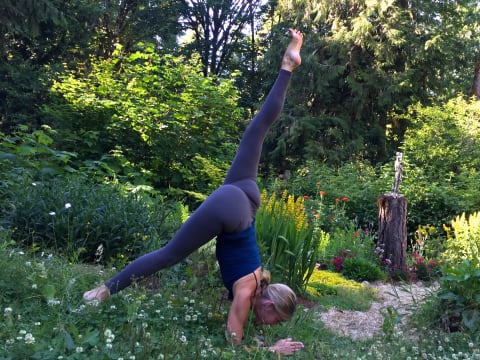
Take your time and move through a warm-up sequence, such as a salutation or gentle flow of your choice.
Ether is most readily accessed when the body feels at ease, warm, and energetically balanced. Find your way into a downward-facing dog and take three to five breaths. Lower yourself down to your forearms. Nod your head gently and then find a gaze slightly out over your hands.
Raise one leg to the sky from forearm variation of downward-facing dog (often called dolphin) with your fingertips touching. Take five generous breaths. Lower your skyward leg, placing your feet shoulder-width apart, and repeat on the other side.
Supported Headstand (Salamba Sirsasana)
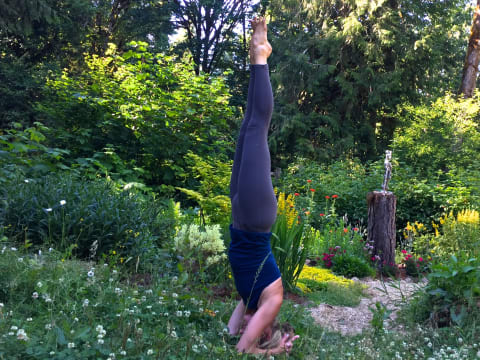
From dolphin, clasp your hands, maintaining space between your palms. Lower your head gently into the space created between your palms.
Raise your legs (one at a time or both) to the sky, finding your way into supported headstand. It is acceptable to do this pose near a wall if you desire or require the extra support. Most importantly, avoid placing excessive weight on your head, keeping the weight strongly in the forearms, with your shoulder blades drawing toward the midline of the back. Press the ball mounds of your feet toward the sky and lift the low belly.
Hold this pose for upward of one minute. Slowly begin to crease at the hips, sending your bottom behind you as you lower your extended legs slowly and steadily to the floor. Take a gentle child's pose, resting here for one minute or more.
Wide-Legged Supported Headstand (Prasarita Salamba Sirsasana)
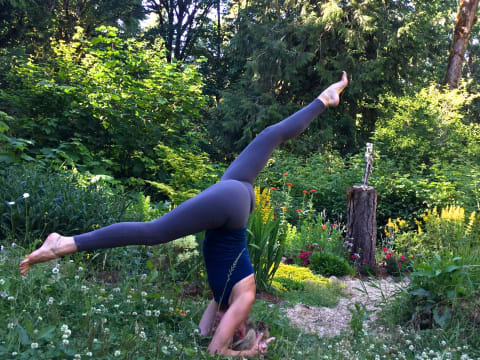
Find your way, once again, into supported headstand.
Breathing slowly and deeply, begin to separate your legs broadly, reaching your feet out to the horizon in opposite directions, taking a wide-legged position of your choice.
Complete this pose by returning again to your supported headstand. Take five breaths here and exit the pose steadily, returning to child pose. Rest here for upward of one minute.
One-Legged Wheel (Eka Pada Chakrasana)
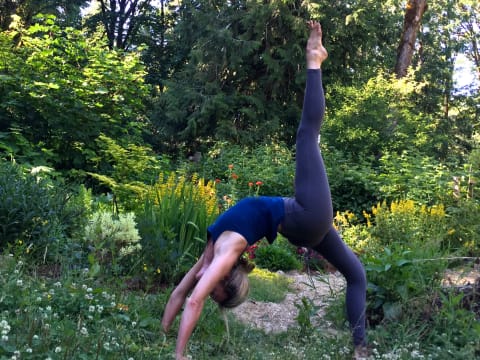
Find your way onto your back side and raise yourself up to wheel pose.
Press firmly through both feet, shoulder-width apart, and extend your arms vertically to the best of your ability. Take three to five breaths here before raising one leg to the sky, pressing upward through the ball mound of the foot. Keep the hips square and take three to five breaths here. Lower the skyward leg an repeat on the opposite side. Begin to gently tuck your chin as you lower yourself to the ground, resting your knees against each other and turning your toes in gently.
Rest here for upward of one minute.
Forearm Wheel (Bahu Chakrasana)
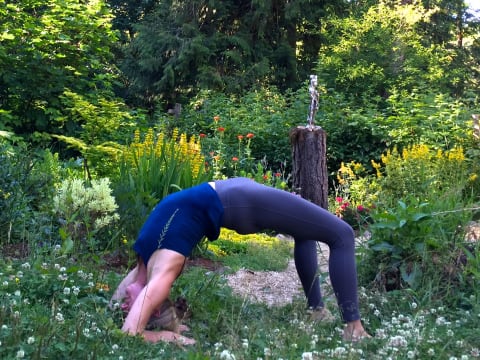
Again, raise yourself up to wheel pose.
Take three breaths and slowly lower yourself, one arm at a time to your forearms, into forearm wheel pose. Take three to five breaths here and then slowly exit the pose the way you entered.
If this is not in your current practice, repeat the full expression of wheel pose. Rest again on your backside with knees bent and feet wider than the hips, toes turned gently in with knees touching. Rest here for one minute or more.
Simple Seated Pose (Sukhasana)
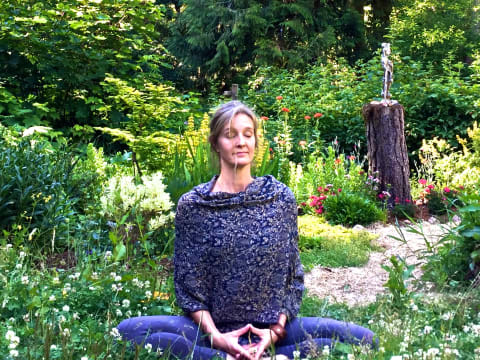
Draw your knees to your chest, one at a time, and take five breaths. Slowly roll yourself over onto your right side, using the exhale to release anything you may have "dislodged" through this sequence.
Raise yourself up to your favorite seat, maintaining an eyes-closed position, and make a gesture with your hands that feels organic and right. The pose pictured is yoni mudra, a receptive gesture that supports graceful acceptance of all that is in life—however it chooses to reveal.
Take this pose (simple seated pose) and mudra, or gesture, of your choice as a meditation, reflecting on the inversion and spinal extension sequence you just completed and what may have "risen to the top" for you as a result. Notice whether you were able to access freedom, even when the pose was challenging or intense, physically and emotionally.
Notice you current breathing pattern, state of mind, and your heart space. Stay in this pose for 10 to 30 minutes before settling into a final, complete resting pose (perhaps savasana).
